To avoid color mistakes in your home, start by testing large paint samples in different lighting conditions. Daylight changes how colors appear, so observe them at various times. Pay attention to undertones to guarantee they complement your furniture and decor. Limit your color palette to three main shades for unity, using varying tones to add depth. Neutral colors like beige or muted blues provide a timeless backdrop. Finally, resist overly trendy shades to maintain lasting appeal. With these tips in mind, you'll create a harmonious space that reflects your style and vibe. There's even more to explore for a perfect palette!
Key Takeaways
- Test large paint samples in different lighting conditions to accurately perceive color changes throughout the day.
- Consider the undertones of colors to ensure they complement existing furniture and decor.
- Limit your color palette to three main colors for a cohesive and harmonious look.
- Opt for timeless colors like neutrals or muted shades to avoid future dissatisfaction with trends.
- Avoid overly bright colors in workspaces to maintain a positive mood and enhance productivity.
Common Color Mistakes
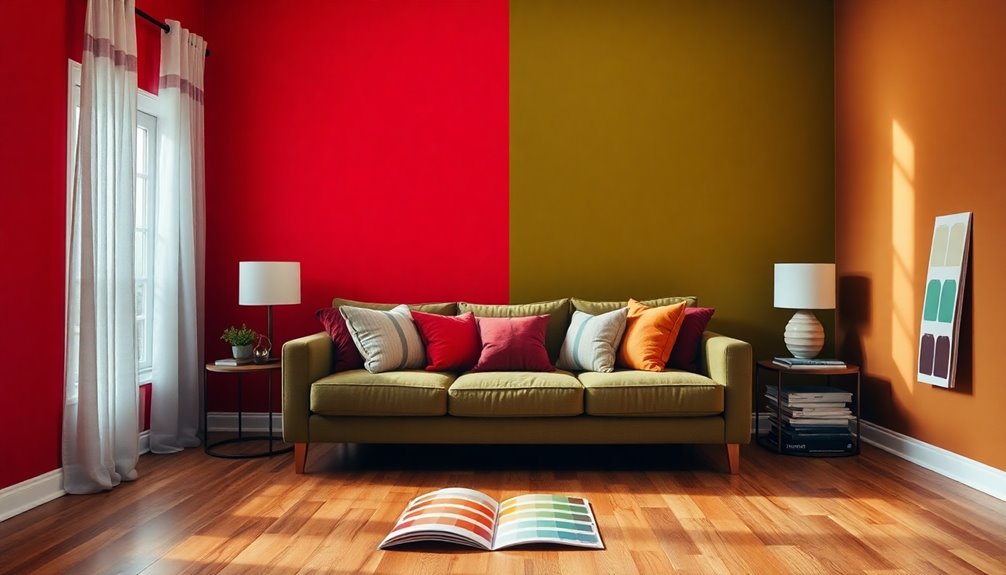
When you're choosing colors for your home, you mightn't realize the common mistakes that can lead to disappointment. One major issue is relying solely on paint samples. These small chips often misrepresent how paint colors look on your walls due to variations in natural light and surface texture. It's important to test different colors in various lighting conditions throughout the day to see how they actually appear. Additionally, consider the use of neutral color palettes, which are popular in modern farmhouse design, to create a cohesive and calming environment.
Ignoring undertones is another common pitfall. For instance, selecting a beige with cool undertones might clash with your warm-toned furniture, creating discord in your space. You should also consider the function of each room; overly bright colors in a workspace can negatively impact your mood and productivity. Additionally, integrating smart lighting can help adjust the perception of colors throughout the day, enhancing the overall aesthetic.
Finally, over-accessorizing with mismatched colors disrupts visual harmony. To avoid this, limit your palette to three main colors that complement each other.
The Role of Lighting
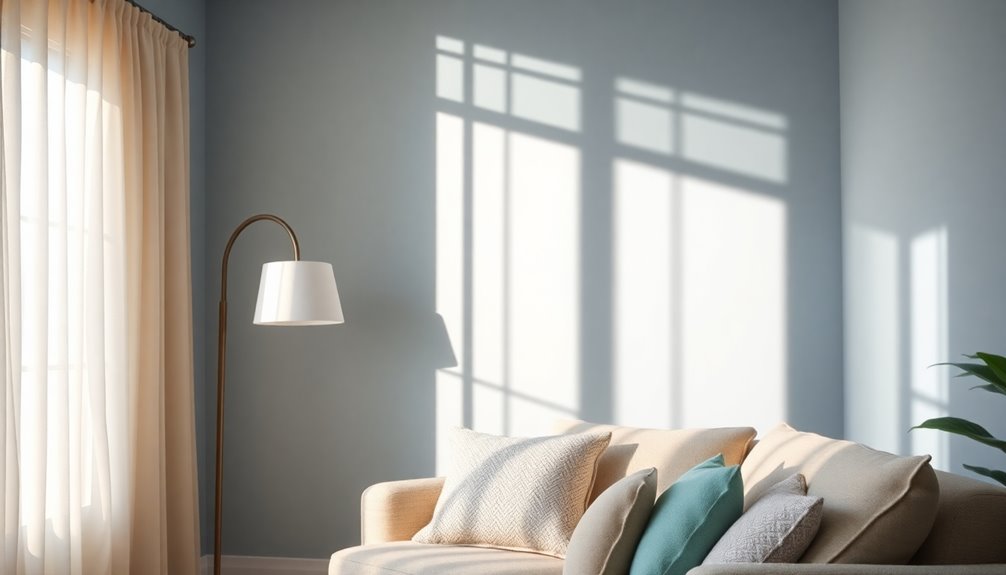
Lighting plays an essential role in how colors are perceived in your home, influencing everything from mood to aesthetics. The type and direction of light can dramatically alter the appearance of paint samples, so understanding your room's lighting is vital.
For instance, south or west-facing rooms may thrive with brighter colors, while north-facing ones might need lighter shades to combat shadows.
To guarantee you achieve the desired effect, consider these points:
- Observe natural light changes throughout the day to gauge true color.
- Test paint samples under both natural and artificial lighting to see how colors interact.
- Be aware of the different walls in your space since they can reflect light differently.
- Pay attention to undertones, as they can clash with various lighting types, affecting your overall look.
Effective Color Testing
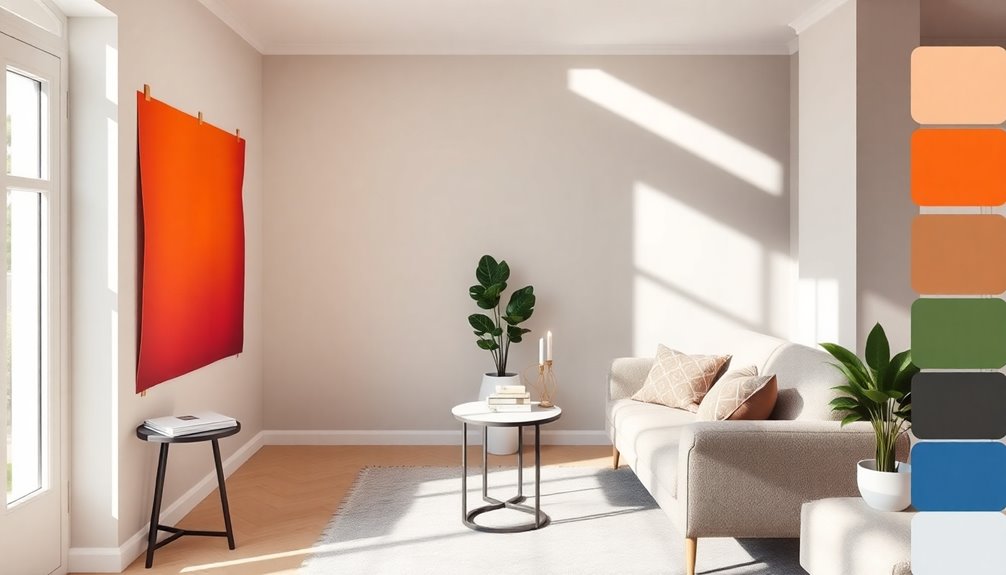
To guarantee you choose the right paint color for your home, testing is essential. Start by using large paint samples instead of small paint chips. Larger samples provide a better representation of how different colors will appear in your room. Next, observe your paint samples at various times throughout the day. Natural light can greatly influence the color's look, so it's crucial to see how it changes.
Here's a simple guide to help you effectively test paint colors:
| Time of Day | Observation Notes | Light Conditions |
|---|---|---|
| Morning | Color appears cooler | Soft, diffused light |
| Afternoon | Color seems warmer | Bright, direct light |
| Evening | Color looks darker or muted | Dim, ambient light |
When applying paint samples, avoid painting over existing wall colors. Instead, use a clean, white surface and add a band of white around the sample to isolate it. This helps you evaluate how the new color interacts with the room's overall palette, ensuring you make the right choice.
Creating Visual Harmony
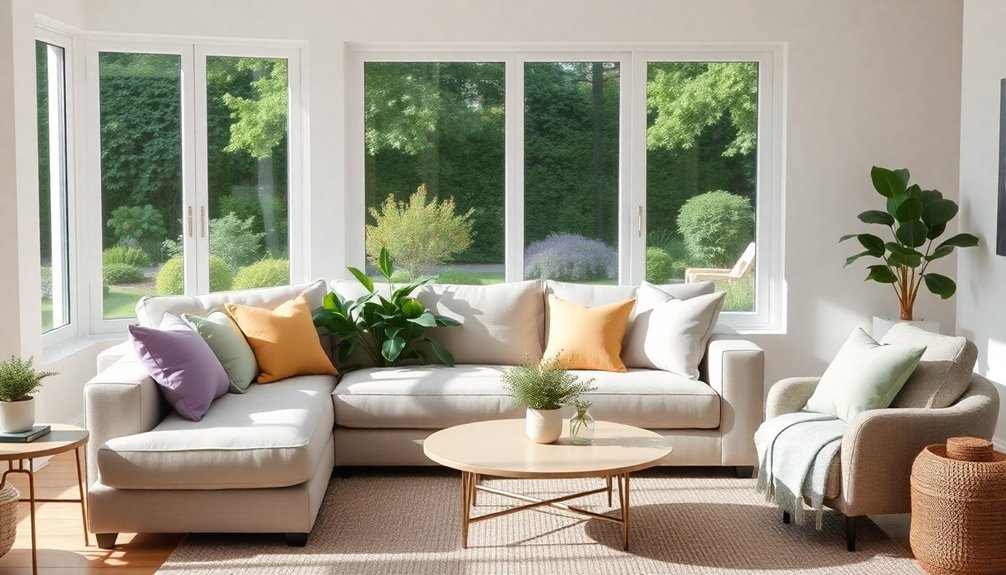
Creating visual harmony in your home can transform a space from chaotic to cohesive. Start by selecting a limited color palette with no more than three main colors. This helps prevent fragmentation and guarantees your design feels unified.
You might consider using varying shades of a single color, enhancing depth while maintaining a monochromatic scheme. This approach adds visual interest without overwhelming the space.
When using accent colors, be strategic. Highlight architectural features or focal points to provide contrast without disrupting harmony. Gradual shifts between colors in open-concept areas create flow, connecting different spaces while allowing them to maintain their unique identities.
Here are some tips to achieve visual harmony:
- Limit your color selections to three main colors.
- Explore varying shades of a chosen color for depth.
- Choose accent colors that complement your main palette.
- Pay attention to color undertones to avoid clashing.
- Consider how smart bathroom technologies can enhance your home's overall aesthetic and functionality.
Understanding these principles can help you create a warm, inviting atmosphere, guaranteeing your home reflects a cohesive and harmonious design.
Choosing Timeless Colors
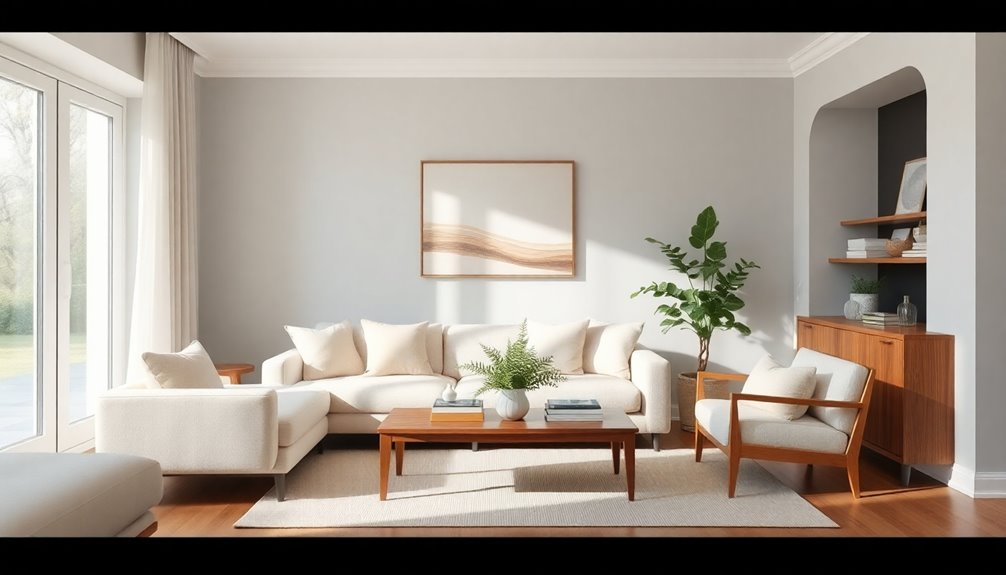
Choosing the right colors for your home is essential for achieving a timeless aesthetic that withstands changing trends. Start by opting for neutral colors like beige, gray, or greige, as these versatile backdrops can easily adapt to your evolving decor over time.
Incorporate timeless shades such as soft whites, muted blues, or earthy greens. These options not only create a calming atmosphere but also guarantee enduring appeal.
While it's tempting to jump on the latest color trends, avoid overly trendy colors that may lead to dissatisfaction in the long run. Focus on your personal preferences to ensure lasting enjoyment of your space.
Researching color trends alongside classic palettes can help you strike a balance between trendy and timeless choices, enhancing your home's aesthetic longevity.
Frequently Asked Questions
What Color Would You Never Use in Your Home?
You might want to avoid colors like neon yellow or electric pink in your home.
They can overwhelm a space, making it feel chaotic and uninviting.
Dark colors, such as deep burgundy or navy blue, can also create a cramped atmosphere if not paired with good lighting.
Additionally, trendy colors like millennial pink can quickly go out of style, leaving you with a look that feels outdated and unappealing.
Choose wisely!
What Room Color Makes a House Lose Value?
You might think a bold, deep red would make your living room feel like a cozy retreat, but it can actually shrink the space and make it feel less inviting. Bold color choices in interiors can be a double-edged sword. While they can add a burst of personality and energy to a room, they can also overpower the space and create a sense of unease. It’s important to carefully consider the impact of bold colors on the overall feel of a room, and to balance them with more neutral tones to create a harmonious and inviting atmosphere.
Similarly, trendy neon colors might seem fun, but they could scare off potential buyers.
Opting for outdated shades, like avocado green, could also seriously hurt your home's value.
Stick to neutral or timeless hues to keep your space appealing and market-ready.
Is It Okay to Paint Every Room in Your House a Different Color?
It's totally okay to paint every room in your house a different color! This approach can add personality and vibrancy to your space.
Just make sure the colors you choose complement each other to maintain a cohesive look. Think about the function of each room, too—calming hues work well in bedrooms, while energizing shades can liven up living areas.
Testing colors in the actual space helps you see how they interact with lighting.
What Color Is Replacing Gray in 2024?
Imagine stepping into a warm, sunlit room, where the walls embrace you with shades of beige and soft terracotta.
In 2024, these inviting hues are set to replace the cool grays of the past.
You'll find earthy tones, soft greens, and muted yellows creating a serene atmosphere that feels like a gentle hug.
This trend reflects a desire for comfort and connection to nature, transforming your space into a cozy retreat.









